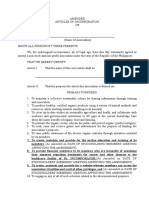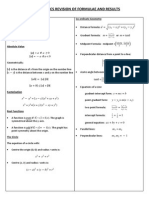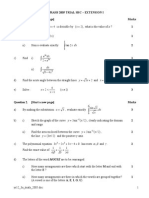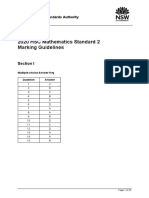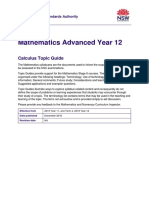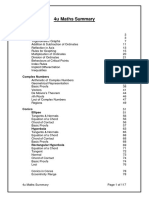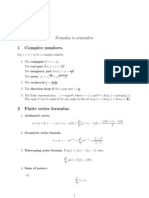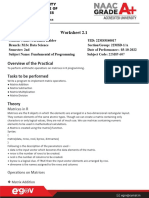HSC 3U Maths Formulae
HSC 3U Maths Formulae
Uploaded by
Hotz InatorCopyright:
Available Formats
HSC 3U Maths Formulae
HSC 3U Maths Formulae
Uploaded by
Hotz InatorOriginal Description:
Copyright
Available Formats
Share this document
Did you find this document useful?
Is this content inappropriate?
Copyright:
Available Formats
HSC 3U Maths Formulae
HSC 3U Maths Formulae
Uploaded by
Hotz InatorCopyright:
Available Formats
MATHEMATICS REVISION OF FORMULAE AND RESULTS
Surds
- a b = ab
-
a
b
=
a
b
- (a)
2
= a
Absolute Value
a = a if a 0
a = a if a < 0
Geometrically:
x is the distance of x from the origin on the number line
x y is the distance between x and y on the number line
ab = a.b
a + b a + b
Factorisation
x
3
y
3
= x y(x
2
+ xy + y
2
)
x
3
+ y
3
=x + y(x
2
xy + y
2
)
Real Functions
- A function is even if fx = f(x). The graph is
symmetrical about the y-axis.
- A function is odd if fx= f(x). The graph has
point symmetry about the origin.
The Circle
The equation of a circle with:
- Centre the origin (0, 0) and radius r units is:
x
2
+ y
2
= r
2
- Centre (a, b) and radius r units is:
(x a)
2
+ (y b)
2
= r
2
Co-ordinate Geometry
- Distance formula: d = x
2
x
1
2
+ (y
2
y
1
)
2
- Gradient formula: m =
y
2
y
1
x
2
x
1
or m = tan
- Midpoint Formula: midpoint =
x
1
+ x
2
2
,
y
1
+ y
2
2
- Perpendicular distance from a point to a line:
ax
1
+ by
1
+ c
a
2
+ b
2
- Acute angle between two lines (or tangents)
tan =
m
1
m
2
1 + m
1
m
2
- Equations of a Line
gradient-intercept form: y = mx + b
point-gradient form: y y
1
= m(x x
1
)
two point formula:
y y
1
x x
1
=
y
2
y
1
x
2
x
1
intercept formula:
x
a
+
y
b
= 1
general equation: ax + by + c = 0
- Parallel lines: m
1
= m
2
- Perpendicular lines: m
1
.m
2
= 1
Trigonometric Results
- sin =
opposite
hypotenuse
(SOH)
- cos =
adjacent
hypotenuse
(CAH)
- tan =
opposite
adjacent
(TOA)
- Complementary ratios:
sin90 = cos
cos90 = sin
tan90 = cot
sec90 = cosec
cosec(90 ) = sec
- Pythagorean Identities
sin
2
+ cos
2
= 1
1 + cot
2
= cosec
2
tan
2
+ 1 = sec
2
tan =
sin
cos
and cot =
cos
sin
- The Sine Rule
a
sinA
=
b
sinB
=
c
sinC
- The Cosine Rule
a
2
= b
2
+ c
2
2bcCosA
CosA =
b
2
+ c
2
a
2
2bc
- The Area of a Triangle
Area =
1
2
abSinC
The Quadratic Polynomial
- The general quadratics is: y = ax
2
+ bx + c
- The quadratic formula is: x =
b
b
2
4ac
2a
- The discriminant is: = b
2
4ac
If 0 the roots are real
If < 0 the roots are not real
If = 0 the roots are equal
If is a perfect square, the roots are rational
- If and are the roots of the quadratic equation
ax
2
+ bx + c = 0
then: + =
b
a
and =
c
a
- The axis of symmetry is: x =
b
2a
- If a quadratic function is positive for all values of x, it is
positive definite i.e. < 0 and a > 0
- If a quadratic function is negative for all values of x, it
is negative definite i.e. < 0 and a < 0
- If a function is sometimes positive and sometimes
negative, it is indefinite i.e. > 0
The Parabola
- The parabola x
2
= 4ay has vertex (0,0), focus (0,a),
focal length a units and directrix y = a
- The parabola (x h)
2
= 4a(y k) has vertex (h, k)
Differentiation
- First Principles:
f ' (x) =
lim
h
f (x + h) f (x)
h
or
f ' (c) =
lim
x c
f (x) f (c)
h
- If y = x
n
then
dy
dx
= nx
n1
- Chain Rule:
d
dx
f (u) = f ' (u)
du
dx
- Product Rule: If y = uv then
dy
dx
= u
dv
dx
+ v
du
dx
- Quotient Rule: If y =
u
v
then
dy
dx
=
v
du
dx
+ u
dv
dx
v
2
- Trigonometric Functions:
d
dx
sinx = cosx
d
dx
cosx = sinx
d
dx
tanx = sec
2
x
- Exponential Functions:
d
dx
e
f (x)
= f ' (x)e
f (x)
d
dx
a
x
= a
x
.lna
- Logarithmic Functions:
d
dx
log
e
f (x) =
f ' (x)
f (x)
Geometrical Applications of Differentiation
- Stationary points:
dy
dx
= 0
- Increasing function:
dy
dx
> 0
- Decreasing function:
dy
dx
< 0
- Concave up:
d
2
y
dx
2
< 0
- Concave down:
d
2
y
dx
2
> 0
- Minimum turning point:
dy
dx
= 0 and
d
2
y
dx
2
> 0
- Maximum turning point:
dy
dx
= 0 and
d
2
y
dx
2
< 0
- Points of inflexion:
d
2
y
dx
2
= 0 and concavity changes
about the point.
- Horizontal points of inflexion:
dy
dx
= 0 and
d
2
y
dx
2
= 0 and
concavity changes about the point.
Approximation Methods
- The Trapezoidal Rule:
f xdx =
h
2
y
0
+ y
n
+ 2y
1
+ y
2
+ y
3
+ + y
n1
b
a
- Simpsons Rule:
f xdx =
h
3
y
0
+ y
n
+ 4y
1
+ y
3
+ + 2y
2
+ y
4
+
b
a
In both rules, h =
b a
n
where n is the number of strips.
Integration
- If f (x) 0 for a x b, the area bounded by the
curve y = f (x), the x-axis and x = a and x = b is given
by f x dx
b
a
.
- The volume obtained by rotating the curve y = f (x)
about the x-axis between x = a and x = b is given by
f x
2
b
a
- If
dx
dx
= x
n
then y =
x
n+1
n + 1
- If
dx
dx
= ax + b
n
then y =
ax + b
n
a(n + 1)
- Trigonometric Functions:
sin x dx = cosx + C
cos x dx = sinx + C
sec
2
x dx = tanx + C
- Exponential Functions:
e
ax
dx =
e
ax
a
+ C and a
x
dx =
1
lna
.a
x
- Logarithmic Functions:
f ' (x)
f (x)
dx = log
e
x + C
Sequences and Series
- Arithmetic Progression
d = U
2
U
1
U
n
= a + n 1d
S
n
=
n
2
[2a + n 1d]
S
n
=
n
2
[a + l] where l is the last term
- Geometric Progression
r =
U
2
U
1
U
n
= ar
n1
S
n
=
ar
n
1
1
=
a1 r
n
1 r
S
=
a
1 r
The Trigonometric Functions
- t radians = 180
- Length of an arc: l = r
- Area of a sector: A =
1
2
r
2
- Area of a segment: A =
1
2
r
2
( sin)
[In these formulae, u is measured in radians.]
- Small angle results:
sinx 0
cosx 1
tanx 0
lim
x 0
sinx
x
=
lim
x 0
tanx
x
= 1
- For y = sin nx and y = cos nx the period is
2
n
- For y = sin nx the period is
n
Logarithmic and Exponential Functions
- The Index Laws:
a
x
a
y
= a
x+y
a
x
a
y
= a
xy
a
x
y
= a
xy
a
x
=
1
a
x
a
x
y
= a
x
y
a
0
= 1
- The logarithmic Laws:
If log
a
b = c then a
c
= b
log
a
x + log
a
y = log
a
xy
log
a
x log
a
y = log
a
x
y
log
a
n
+ nlog
a
x
log
a
a = 1 and log
a
1 = 0
- The Change of Base Result:
log
a
b =
log
e
b
log
e
a
=
log
10
b
log
10
a
EXTENSION 1 REVISION OF FORMULAE AND RESULTS
Co-ordinate Geometry
- Dividing an interval in the ratio m:n
mx
2
+ nx
1
m + n
,
my
2
+ ny
1
m + n
- Acute angle between two lines (or tangents)
tan =
m
1
m
2
1 + m
1
m
2
Trigonometric Ratios
- Sum and Difference Results
sin(A + B) = sinA cosB + cosA sinB
sin(A B) = sinA cosB cosA sinB
cos(A + B) = cosA cosB sinA sinB
cos(A B) = cosA cosB + sinA sinB
tan(A + B) =
tanA + tanB
1 tanAtanB
tan(A B) =
tanA tanB
1+ tanAtanB
- Double Angle Results
sin2A = 2sinA cosA
cos2A = cos
2
A sin
2
A
cos2A = 1 2sin
2
A
cos2A = 2cos
2
A 1
tan2A =
2tanA
1 tan
2
A
- The t Formulae where t = tan
2
sin x =
2t
1+ t
2
cos x =
1 t
2
1+ t
2
tan x =
2t
1 t
2
- Subsidiary Angle Method (Rsin( + ))
When solving asin + bcos = c we can
solve by writing in the form Rsin( + ) = c
where:
R = a
2
+ b
2
and tan =
b
a
Parameters
- The parametric equations for the parabola
x
2
= 4ay are x = 2at and y = at
2
- All other formulae in this subject are not to be
committed to memory but students must know
how they are derived.
Polynomials
- A real polynomial is in the form:
P(x) = p
n
x
2
+ p
n-1
x
n-1
+ ... p
2
x
2
+ p
1
x + p
0
- p
1
, p
2
, p
3
, ....., p
n
are coefficients and are real
numbers, usually integers.
- The degree of the polynomial is the highest power
of x with non-zero coefficient.
- A polynomial of degree n has at most n real roots
but may have less.
- The result of a long division can be written in the
form P(x) = A(x) . Q(x) + R(x)
- The remainder theorem states that when P(x) is
divided by (x a) the remainder is P(a).
- The factor theorem states that if x = a is a factor
of P(x) then P(a) = 0.
- If o, |, , o, ... are the roots of a polynomial then
Eo =
b
a
, Eo| =
c
a
, Eo| =
d
a
, Eo|o =
e
a
Numerical Estimation of the Roots of an Equation
- Halving the Interval Method
- Newtons Method
If x = x
0
is an approximation to a root of
P(x) = 0 then x
1
= x
0
P(x
0
)
P' (x
0
)
is generally a
better approximation.
Be familiar with the conditions under which
this method fails.
Mathematical Induction
- Step 1: Prove result true for n = 1 (It is
sometimes necessary to have a
different first step.)
- Step 2: Assume it is true for n = k and then
prove true for n = k + 1
- Step 3: Conclusion as given in class
Integration
- sin
2
d and cos
2
d can be solve using the
substitutions:
sin
2
u =
1
2
1 cos2
cos
2
u =
1
2
1 + cos2
- Integration by first making a substitution.
- Table of Standard Integrals as provided in HSC
Inverse Trigonometric Functions
- y = sin
-1
x Domain: 1 s x s 1
Range:
2
y
2
y = cos
-1
x Domain: 1 s x s 1
Range: 0 y t
y = tan
-1
x Domain: all real x
Range:
2
y
2
- Properties:
sin
-1
(-x) = -sin
-1
x
cos
-1
(-x) = t cos
-1
x
tan
-1
(-x) = tan
-1
x
sin
-1
x + cos
-1
x =
2
sin(sin
-1
x) = x
cos(cos
-1
x) = x
tan(tan
-1
x) = x
- General Solutions of Trigonometric Equations:
if sinu = q, then u = nt + (1)
n
sin
-1
q
if cosu = q, then u = 2nt cos
-1
q
if tanu = q, then u = nt + tan
-1
q
- Derivatives:
d
dx
sin
-1
x =
1
1 x
2
d
dx
cos
-1
x =
1
1 x
2
d
dx
tan
-1
x =
1
1 + x
2
- Integrals:
1
a
2
x
2
= sin
-1
x
a
= cos
-1
x
a
1
a
2
+ x
2
=
1
a
tan
-1
x
a
You might also like
- Microsoft Word - Calculus 2 Formula Cheat Sheet83% (6)Microsoft Word - Calculus 2 Formula Cheat Sheet2 pages
- 3U HSC Questions by Topic 1990-2006 21050750% (2)3U HSC Questions by Topic 1990-2006 210507169 pages
- Chemistry Heinemann U4 Workbook Solutions, 2 (3rd Edition)100% (1)Chemistry Heinemann U4 Workbook Solutions, 2 (3rd Edition)20 pages
- Mex c1 Further Work With Vectors Showcloze 200704100% (1)Mex c1 Further Work With Vectors Showcloze 20070461 pages
- Generalized Correlation For Mass Transfer in Packed Distillation Columns PDFNo ratings yetGeneralized Correlation For Mass Transfer in Packed Distillation Columns PDF9 pages
- Mathematics Revision of Formulae and Results: Surds Co-Ordinate GeometryNo ratings yetMathematics Revision of Formulae and Results: Surds Co-Ordinate Geometry5 pages
- 2019 4U - ST George Girls - Trial Paper (With Solutions)No ratings yet2019 4U - ST George Girls - Trial Paper (With Solutions)24 pages
- Hurlstone Agricultural High School: Mathematics - Extension TwoNo ratings yetHurlstone Agricultural High School: Mathematics - Extension Two3 pages
- Advanced Mathematics Calculus Topic GuideNo ratings yetAdvanced Mathematics Calculus Topic Guide16 pages
- HSC 4 Unit Extension 2 Mathematics Dot Point Outline100% (4)HSC 4 Unit Extension 2 Mathematics Dot Point Outline117 pages
- Extension 2 Past Paper Questions by Topic2 PDFNo ratings yetExtension 2 Past Paper Questions by Topic2 PDF20 pages
- Mathematics Advanced Year 11 Topic Guide CalculusNo ratings yetMathematics Advanced Year 11 Topic Guide Calculus11 pages
- Mathematics Course - HSC - 2014 To 2006 PDFNo ratings yetMathematics Course - HSC - 2014 To 2006 PDF2 pages
- Mathematics Extension 2: MEX-V1 Further Work With VectorsNo ratings yetMathematics Extension 2: MEX-V1 Further Work With Vectors41 pages
- 1 1 1 Tan Tan Tan 1 2 1 2 3 1 3 4 + + + + + + 1 ...... Tan 1 1 + + + Sin Cos 1 Sin +No ratings yet1 1 1 Tan Tan Tan 1 2 1 2 3 1 3 4 + + + + + + 1 ...... Tan 1 1 + + + Sin Cos 1 Sin +10 pages
- Sample Questions New HSC English STD Paper 1 Exam 2019No ratings yetSample Questions New HSC English STD Paper 1 Exam 201924 pages
- 2020 MS - Blacktown Boys HS - Trial Paper (With Solutions) PDF100% (1)2020 MS - Blacktown Boys HS - Trial Paper (With Solutions) PDF60 pages
- Practice Questions: Terry Lee Advanced MathematicsNo ratings yetPractice Questions: Terry Lee Advanced Mathematics3 pages
- Mathematics Revision of Formulae and Results: Surds Co-Ordinate GeometryNo ratings yetMathematics Revision of Formulae and Results: Surds Co-Ordinate Geometry5 pages
- Maths Concepts and Formulae: y FX F y XNo ratings yetMaths Concepts and Formulae: y FX F y X16 pages
- Trigonometric Ratios to Transformations (Trigonometry) Mathematics E-Book For Public ExamsFrom EverandTrigonometric Ratios to Transformations (Trigonometry) Mathematics E-Book For Public Exams5/5 (1)
- Common Archetypes and Symbols in LiteratureNo ratings yetCommon Archetypes and Symbols in Literature5 pages
- Software Design and Development HSC Half Yearly NotesNo ratings yetSoftware Design and Development HSC Half Yearly Notes6 pages
- List of Newly and Migrated Programs For September 2023 - WebsiteNo ratings yetList of Newly and Migrated Programs For September 2023 - Website39 pages
- C15 & B40 Service Sheets Book 00-4082 X PDF100% (1)C15 & B40 Service Sheets Book 00-4082 X PDF90 pages
- Control Valves: Environmental Pit Box GBMY 5050M2 SeriesNo ratings yetControl Valves: Environmental Pit Box GBMY 5050M2 Series4 pages
- Match A: Organized - By:, ICT Sector Trainers. Read For More Understanding, Only Chance Will Not Bring Satisfaction!No ratings yetMatch A: Organized - By:, ICT Sector Trainers. Read For More Understanding, Only Chance Will Not Bring Satisfaction!17 pages
- NYC Box 2 AA 11 DOT-FAA Docs FDR - Transcript - Boston ARTCC Utica Sector 09 - Radar Position 1220-1236 UTC - David McGlauflinNo ratings yetNYC Box 2 AA 11 DOT-FAA Docs FDR - Transcript - Boston ARTCC Utica Sector 09 - Radar Position 1220-1236 UTC - David McGlauflin8 pages
- Effect of Inductive Thinking Model On Achievement in Scientific Creativity of Class IX StudentsNo ratings yetEffect of Inductive Thinking Model On Achievement in Scientific Creativity of Class IX Students6 pages
- Kebele_House_Rent_and_Record_Management_System_v2No ratings yetKebele_House_Rent_and_Record_Management_System_v23 pages
- Interview Prep: How To Guide: Laura Ballantyne - August 2020No ratings yetInterview Prep: How To Guide: Laura Ballantyne - August 202011 pages
- Classroom Management Practices of Teachers and Academic Performance of Grade 3 Learners Across All Learning AreasNo ratings yetClassroom Management Practices of Teachers and Academic Performance of Grade 3 Learners Across All Learning Areas10 pages
- Musks Family: Family Brief Perfumery TipNo ratings yetMusks Family: Family Brief Perfumery Tip8 pages
- Chemistry Heinemann U4 Workbook Solutions, 2 (3rd Edition)Chemistry Heinemann U4 Workbook Solutions, 2 (3rd Edition)
- Generalized Correlation For Mass Transfer in Packed Distillation Columns PDFGeneralized Correlation For Mass Transfer in Packed Distillation Columns PDF
- Mathematics Revision of Formulae and Results: Surds Co-Ordinate GeometryMathematics Revision of Formulae and Results: Surds Co-Ordinate Geometry
- 2019 4U - ST George Girls - Trial Paper (With Solutions)2019 4U - ST George Girls - Trial Paper (With Solutions)
- Hurlstone Agricultural High School: Mathematics - Extension TwoHurlstone Agricultural High School: Mathematics - Extension Two
- HSC 4 Unit Extension 2 Mathematics Dot Point OutlineHSC 4 Unit Extension 2 Mathematics Dot Point Outline
- Mathematics Extension 2: MEX-V1 Further Work With VectorsMathematics Extension 2: MEX-V1 Further Work With Vectors
- 1 1 1 Tan Tan Tan 1 2 1 2 3 1 3 4 + + + + + + 1 ...... Tan 1 1 + + + Sin Cos 1 Sin +1 1 1 Tan Tan Tan 1 2 1 2 3 1 3 4 + + + + + + 1 ...... Tan 1 1 + + + Sin Cos 1 Sin +
- Sample Questions New HSC English STD Paper 1 Exam 2019Sample Questions New HSC English STD Paper 1 Exam 2019
- 2020 MS - Blacktown Boys HS - Trial Paper (With Solutions) PDF2020 MS - Blacktown Boys HS - Trial Paper (With Solutions) PDF
- Practice Questions: Terry Lee Advanced MathematicsPractice Questions: Terry Lee Advanced Mathematics
- Mathematics Revision of Formulae and Results: Surds Co-Ordinate GeometryMathematics Revision of Formulae and Results: Surds Co-Ordinate Geometry
- Trigonometric Ratios to Transformations (Trigonometry) Mathematics E-Book For Public ExamsFrom EverandTrigonometric Ratios to Transformations (Trigonometry) Mathematics E-Book For Public Exams
- Shortcuts to College Calculus Refreshment KitFrom EverandShortcuts to College Calculus Refreshment Kit
- Transformation of Axes (Geometry) Mathematics Question BankFrom EverandTransformation of Axes (Geometry) Mathematics Question Bank
- Software Design and Development HSC Half Yearly NotesSoftware Design and Development HSC Half Yearly Notes
- List of Newly and Migrated Programs For September 2023 - WebsiteList of Newly and Migrated Programs For September 2023 - Website
- Control Valves: Environmental Pit Box GBMY 5050M2 SeriesControl Valves: Environmental Pit Box GBMY 5050M2 Series
- Match A: Organized - By:, ICT Sector Trainers. Read For More Understanding, Only Chance Will Not Bring Satisfaction!Match A: Organized - By:, ICT Sector Trainers. Read For More Understanding, Only Chance Will Not Bring Satisfaction!
- NYC Box 2 AA 11 DOT-FAA Docs FDR - Transcript - Boston ARTCC Utica Sector 09 - Radar Position 1220-1236 UTC - David McGlauflinNYC Box 2 AA 11 DOT-FAA Docs FDR - Transcript - Boston ARTCC Utica Sector 09 - Radar Position 1220-1236 UTC - David McGlauflin
- Effect of Inductive Thinking Model On Achievement in Scientific Creativity of Class IX StudentsEffect of Inductive Thinking Model On Achievement in Scientific Creativity of Class IX Students
- Interview Prep: How To Guide: Laura Ballantyne - August 2020Interview Prep: How To Guide: Laura Ballantyne - August 2020
- Classroom Management Practices of Teachers and Academic Performance of Grade 3 Learners Across All Learning AreasClassroom Management Practices of Teachers and Academic Performance of Grade 3 Learners Across All Learning Areas



